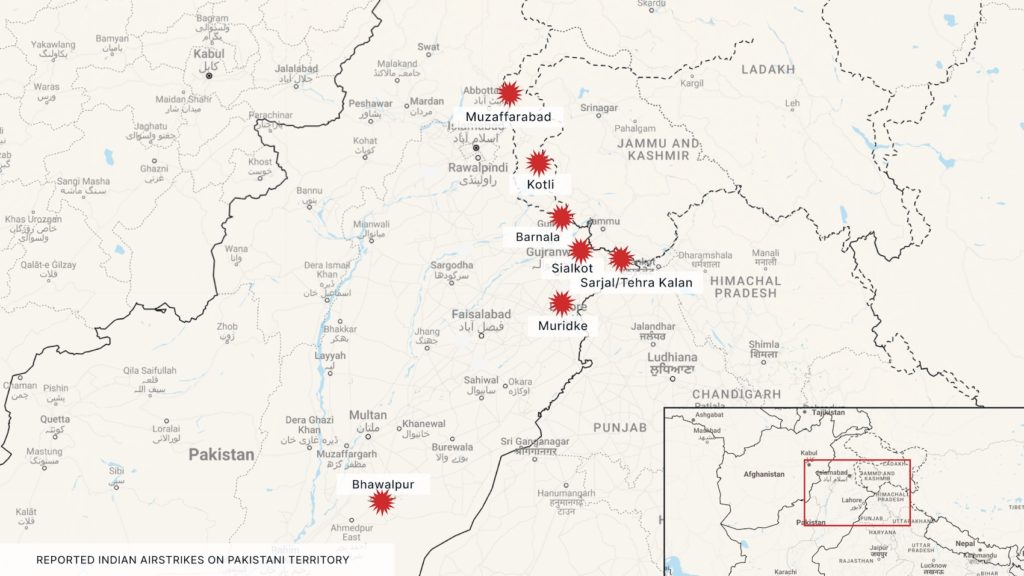Alert+
Evacuations from High-Risk Locations Call +44 (0)1202 308810 or Contact Us →
India Conducts Airstrikes in Pakistan-Administered Kashmir After Pahalgam Terror Attack
Intelligence cut off: 10:00 BST 07 MAY 2025
At approximately 00:30 local time on 7 May, the Indian Air Force (IAF) conducted airstrikes against nine different locations in both Pakistan-administered Kashmir and Pakistan.
Among the areas targeted are Muzaffarabad, Kotli, and Bagh in Pakistan-administered Kashmir, and Sialkot, Sarjal/Tehra Kalan, Muridke, and Bahawalpur in Pakistan. Pakistani Armed Forces (PAF) spokespersons have claimed the attacks resulted in at least 26 dead and 46 injured.
The strikes, codenamed Operation Sindoor, were carried out as part of India’s broader strategy to dismantle terrorist infrastructure in neighbouring Pakistan, following the 22 April attack in Pahalgam. India’s Defence Ministry has declared that it targeted nine different sites considered “terrorist infrastructure” in a “focused, measured, and non-escalatory” manner, with sites allegedly linked to proscribed militant groups like Lashkar-e-Taiba and Jaish-e-Mohammed. No Pakistani military sites were reportedly targeted. Indian officials issued a list of alleged militant camps targeted across Pakistan in the aftermath.

In retaliation, Pakistani forces conducted cross-border shelling in Kashmir, reportedly killing and injuring several civilians, and have claimed to have downed five Indian military aircraft. Flight operations at Karachi’s Jinnah International Airport (KHI) and Lahore’s Allama Iqbal International Airport (LHE) were temporarily suspended overnight due to heightened risks posed by the ongoing aerial engagements.
Similar restrictions have also been implemented across nine airports in northern and western India, with Air India suspending flights to Jammu and Srinagar in Kashmir, Leh, Chandigarh, Jodhpur, Amritsar, Bhuj, Jamnagar, and Rajkot through 10 May.
Air France has suspended flights over Pakistan. Several other airlines have followed suit, re-routing or cancelling flights to and from Europe.
Pakistan’s Prime Minister, Shehbaz Sharif, has described the strikes as an “unprovoked act of war” and referred to the Indian claims of targeting terrorist camps as “false”. Pakistan has justified the retaliatory military action as justified under Article 51 of the United Nations Charter, which allows self-defence in response to armed attack.
Amid the tit-for-tat strikes, both Indian and Pakistani strikes allegedly hit hydropower assets. Unconfirmed reports by Pakistani media have accused India of targeting the Noseri Dam near the Neelum-Jhelum Hydropower Project. Two shells also landed on hydroelectric corporation offices in Indian-administered Kashmir, according to an Indian official.
India’s home ministry ordered mock drills to test preparation for an attack across the country to take place on 7 May, including air raid warning system tests. This constitutes the largest civil defence drill in India since 1971. India’s Air Force is expected to hold drills on the night of 7 May in the west of the country, and Delhi and Bengaluru airports are set to hold disaster management exercises; these are reportedly unlikely to impact passenger operations.
Beijing has declared that it is closely following the situation and has advised its citizens to avoid conflict areas. China’s foreign ministry has urged both India and Pakistan to exercise restraint and refrain from taking escalatory actions.
INTELLIGENCE ANALYSIS
Limited Military Escalation Likely Following India’s Airstrikes on Pakistan Territory
The airstrikes come amid escalatory tit-for-tat actions between India and Pakistan following the Pahalgam attack, which resulted in at least 26 civilian deaths. The attack was allegedly orchestrated by the Resistance Front, a reported offshoot of the Pakistan-linked terror group Lashkar-e-Taiba.
The high civilian toll, almost all of whom were Hindu Indian nationals, has escalated tensions between India and Pakistan, prompting mass deportations and the imposition of airspace restrictions in the days leading up to the 7 May strikes.
There is precedent for India retaliating with airstrikes after perceived Pakistan-backed militant attacks on its territory. In 2016 India launched “surgical strikes” against Pakistan after four militants killed 19 Indian soldiers in Uri, Jammu and Kashmir; in 2019, further strikes were launched in Balakot after 40 Indian paramilitary personnel were killed in a bombing in Pulwama.
Indian strikes on Pakistan have generally been subthreshold, designed to target militant camps to carry out retaliatory measures while not forcing Islamabad into entering into a direct conflict.
While Pakistan has responded with limited artillery shelling along the Line of Control in Jammu and Kashmir, it is likely Pakistan will be forced to respond with airstrikes under mounting public pressure. Pakistani retaliatory strikes are highly likely to be carefully calibrated to remain below the escalation threshold and to avoid triggering a major conflict with a rival nuclear power.
During previous hostilities in 2019, Pakistan refrained from directly targeting Indian military sites, instead striking open areas to demonstrate its capability while limiting civilian casualties. To avoid a major escalation or miscalculation, Pakistan will likely limit its strikes to Indian-administered territory in Jammu and Kashmir.
The targeting of dams, particularly in Indian-administered Kashmir, is highly likely due to India’s perceived weaponisation of water flows after unilaterally pulling out of the Indus Water Treaty. This has significantly escalated tensions between the two sides since it threatens Pakistan’s water supply and agricultural sector, with Pakistan having warned that any attempt from India to disrupt the flow of water from its rivers would be considered an act of war.
Over the past week, India has taken steps to enhance the storage capacity at two hydroelectric facilities in Jammu and Kashmir’s Himalayan region, constituting the first concrete action outside the framework of the Indus Water Treaty. In a highly likely perceived threat to Pakistan’s water supply, India began flushing silt at the Baglihar and Salal dams in the Kashmir valley on 3 May. This would ordinarily only be allowed during the monsoon season, as it involves nearly emptying the reservoirs of silt before closing the dams and slowly refilling them, choking water flow downstream.
Pakistan recorded a significant decrease in the waters of the Chenab River, and since 4 May, almost 90 per cent of the usual volume has been prevented from flowing into the Chenab River.
A full-scale conflict between the two nations remains unlikely despite the airstrikes. For India, a war would highly likely drag the country into a prolonged conflict that would significantly affect its economy. This would almost certainly stretch India’s armed forces, which have been underfunded in recent years, allowing Pakistan to catch up militarily.
Although the US has developed closer ties with India, especially during the Trump administration, a conflict between India and Pakistan would likely impact the global economy, giving the US a strong interest in promoting de-escalation.
Pakistan almost certainly cannot afford to enter a war. Pakistan Armed Forces are currently engaged in a multi-front internal conflict against militant groups, primarily in Balochistan and Khyber Pakhtunkhwa. While its military is more battle-tested than India’s, a war would almost certainly overstretch its armed forces, would risk destabilising the military-dominated government and would provide opportunities for militants to exploit.
Furthermore, a conflict would hinder the country’s progress in stabilising its economy. Pakistan was removed from the Financial Action Task Force (FATF) grey list in 2023 after legislative and institutional reforms to address perceived anti-money laundering and counter-terrorist financing deficiencies. India has indicated plans to advocate for Pakistan’s re-entry in the aftermath of the militant attack, and a war would significantly increase the likelihood of this happening.
Furthermore, a conflict would hinder the country’s progress in stabilising its economy. Pakistan was removed from the Financial Action Task Force (FATF) grey list in 2023 after legislative and institutional reforms to address perceived anti-money laundering and counter-terrorist financing deficiencies. India has indicated plans to advocate for Pakistan’s re-entry in the aftermath of the militant attack, and a war would significantly increase the likelihood of this happening.
If re-added, Pakistan would almost certainly face reduced investment and foreign aid, as well as risk being blacklisted, which would significantly affect is ability to finance its debt repayments.
Given that both nations are nuclear-armed, a full-scale conflict would risk rapid escalation and nuclear war. This acts as a deterrence from escalation for both sides, who will likely favour diplomatic options and limited skirmishes despite the ongoing brinkmanship. Diplomatic pressure will almost certainly be applied by regional powers including China.
Amid heightened sectarian tensions, there will highly likely be increased attacks between Hindus and Muslims in India and Pakistan, with probable clashes during protests. There is a realistic possibility of sectarian tensions also manifesting within diaspora communities, such as within the UK, US, and Canada. Disinformation campaigns framing the attack as a symptom of an inter-religious conflict are likely and will almost certainly exacerbate tensions.
This is especially since the tensions come shortly after Modi passed the Waqf Amendment Act, which changes the way Muslim waqf properties are governed, triggering violent protests by conservative Muslim communities, particularly in West Bengal.
There is a realistic possibility of lone-actor attacks, further inflaming sectarian tensions. Security forces of both countries will almost certainly be at a heightened state of alert during the current tensions, which likely reduces the threshold at which they will respond forcefully to perceived unrest, making clashes between protesters and security forces likely.
Travel Risk Advice: Safety Guidelines for India and Pakistan
- Closely monitor local news reports and government alerts.
- Avoid all non-essential travel to Jammu and Kashmir, as well as Indian-Pakistani border regions.
- Avoid all military installations, government buildings, and key infrastructure.
- Civil unrest and demonstrations are highly likely throughout both India and Pakistan. Travellers are advised to avoid all areas of unrest. Protests are likely to occur near government buildings, foreign embassies, and religious sites.
- Adhere to all instructions issued by authorities.
- Ensure that you contact and register with your local embassy or consulate if stranded in India or Pakistan.
- The security situation in Jammu and Kashmir is likely to remain highly unstable in the coming weeks with an increased potential for further cross-border strikes, terror attacks, and civil unrest.
- Evacuations and internal displacement will almost certainly lead to widespread travel disruption and congestion on major roads. Ensure vehicles are fuelled, consider alternative routes, and ensure that vehicles are loaded with additional fuel, water, food and other critical supplies.
- Confirm booked flights are running before checking out of hotels or travelling to the airport.
- Have emergency contact numbers saved on your phone. These should include the local authorities, medical facilities, and any consular support. Ensure that mobile phones are charged in case of any losses in electricity.
- Monitor the Solace Secure platform and trusted local media for updates relevant to the conflict.

Intelligence Lite
Free
- Weekly Intelligence Email with Key Events
- Alert+ Situation Summary for Immediate Incidents
- Quarterly Global Election Report (Lite Version)
- Yearly Global Risk Outlook (Lite Version)
Intelligence Plus
Full Subscription
- Weekly Global Intelligence (Full Report)
- Alert+ Reports (Summary and Full Analysis)
- Quarterly Live Q&A Webinar with Intelligence Team
- Quarterly Global Election Report (Full Report)
- Yearly Global Risk Outlook
- Ongoing Thematic & Regional Deep Dive Reports
- On-demand Pre-Travel Advisories (2 reports per year)
Subscribe to receive full reports
Join the thousands of risk management professionals that rely on our intelligence every week.
Includes 70+ reports written by expert analysts.
Subscribe